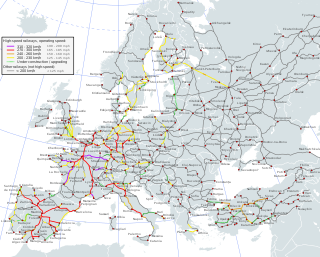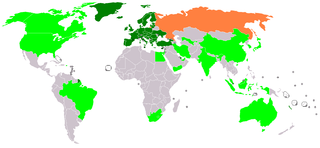Related Research Articles

A directive is a legal act of the European Union that requires member states to achieve particular goals without dictating how the member states achieve those goals. A directive's goals have to be made the goals of one or more new or changed national laws by the member states before this legislation applies to individuals residing in the member states. Directives normally leave member states with a certain amount of leeway as to the exact rules to be adopted. Directives can be adopted by means of a variety of legislative procedures depending on their subject matter.

The European Train Control System (ETCS) is the signalling and control component of the European Rail Traffic Management System (ERTMS). It is a replacement for legacy train protection systems and designed to replace the many incompatible safety systems currently used by European railways. The standard was also adopted outside Europe and is an option for worldwide application. In technical terms it is a type of positive train control (PTC).

Markets in Financial Instruments Directive 2014 commonly known as MiFID 2, is a legal act of the European Union. Together with Regulation (EU) No 600/2014 it provides a legal framework for securities markets, investment intermediaries, and trading venues. The directive provides harmonised regulation for investment services of the member states of the European Economic Area — the EU member states plus Iceland, Norway, and Liechtenstein. Its main objectives are to increase competition and investor protection, and level the playing field for market participants in investment services. It repeals Directive 2004/39/EC.
The European Rail Traffic Management System (ERTMS) is the system of standards for management and interoperation of signalling for railways by the European Union (EU). It is conducted by the European Union Agency for Railways (ERA) and is the organisational umbrella for the separately managed parts of

Rail transport in France is marked by a clear predominance of passenger traffic, driven in particular by high-speed rail. The SNCF, the national state-owned railway company, operates most of the passenger and freight services on the national network managed by its subsidiary SNCF Réseau. France currently operates the second-largest European railway network, with a total of 29,901 kilometres of railway.

Rail transport in Europe is characterized by its diversity, both technical and infrastructural. Electrified railway networks operate at a plethora of different voltages AC and DC varying from 750 to 25,000 volts, and signaling systems vary from country to country, hindering cross-border traffic.

The Capital Requirements Directives (CRD) for the financial services industry have introduced a supervisory framework in the European Union which reflects the Basel II and Basel III rules on capital measurement and capital standards.

The Trans-European high-speed rail network (TEN-R), together with the Trans-European conventional rail network, make up the Trans-European Rail network, which in turn is one of a number of the European Union's Trans-European transport networks (TEN-T). It was defined by the Council Directive 96/48/EC of 23 July 1996.

UNIFE, or the European Rail Supply Industry Association, is an association of Europe's rail supply companies active in the design, manufacture, maintenance and refurbishment of rail transport systems, subsystems and related equipment. UNIFE also brings together 15 national rail industry associations of European countries. UNIFE is a member of the Group of Representative Bodies.

The European Telecommunications Standards Institute (ETSI) is an independent, not-for-profit, standardization organization in the field of information and communications. ETSI supports the development and testing of global technical standards for ICT-enabled systems, applications and services.
The UIC identification marking for tractive stock is a standard for identifying train stock like locomotives that supply tractive force primarily in Europe. Since the beginning of 2007 locomotives or other traction units in Europe have been given a 12-digit number. Vehicle numbering is now governed by the Intergovernmental Organisation for International Carriage by Rail and in Technical Specifications for Interoperability (TSI) of the European Union, specifically the European Railway Agency's CR OPE TSI. This makes the locomotive clearly identifiable within Europe and parts of Asia and northern Africa.
The Single European Railway Directive 20122012/34/EU is an EU Directive that regulates railway networks in European Union law. This recast the "First Railway Directive" or "Package" from 1991, and allows open access operations on railway lines by companies other than those that own the rail infrastructure. The legislation was extended by further directives to include cross border transit of freight.

The Second Railway Package is a group of European Union legislation which promote common standards and open access, working towards an integrated European railway area.

The fourth railway package is a set of changes to rail transport regulation in the European Union law. It covers standards and authorisation for rolling stock; workforce skills; independent management of infrastructure; and the liberalisation of domestic passenger services in an attempt to reduce European rail subsidies.

eIDAS is an EU regulation on electronic identification and trust services for electronic transactions in the European Single Market. It was established in EU Regulation 910/2014 of 23 July 2014 on electronic identification and repeals 1999/93/EC from 13 December 1999.

The European Union Agency for Railways (ERA) is an agency of the European Union (EU) that sets mandatory requirements for European railways and manufacturers in the form of Technical Specifications for Interoperability (TSI), which apply to the Trans-European Rail system. The ERA publishes a document summarising the status of the TSIs. The ERA sets common safety targets, common safety methods and common safety indicators, following Directive 2004/49/EC and amendments. The ERA also hosts a number of databases, among which a register of remaining, applicable national rules.

EN 15227 is a European standard about the crashworthiness requirements for railway vehicle bodies. It was first resolved in 2008 and it is binding since 2012 for all new vehicles in the European Union.
EuroSpec, abbreviation for European Specification for Railway Vehicles, is an initiative of several European railway companies with the aim to develop common, explicit technical specifications for train systems and components. The work program includes doors, parking noise, TCMS, seating comfort and the revision of published specifications. The jointly developed specifications support and facilitate the process of purchasing trains. These specifications are not in the competitive domain. The continued application of the EuroSpec methodology and the developed specifications support the standardisation of trains and lead to higher quality, support the development of vehicle platforms and provide significant cost savings. As a basis for developing their specifications, EuroSpec partners have developed a "Requirement Management" manual to ensure the necessary consistency between the specifications and their quality. The work started in 2011.
The functional requirements for rail vehicles of the EuroSpec specifications are used in procurement in addition to the technical specifications for interoperability, the EN standards and the national notified technical rules (NNTR).
The EuroSpec consortium does not prepare "European Standards" or "International Standards" within the meaning of Regulation (EU) No 1025/2012 of the European Parliament and of the Council of 25 October 2012. EuroSpec specifications should therefore be classified as a "technical specification". They are increasingly used as input for European Standards and Regulations.
In EU law, reverse discrimination occurs when the national law of a member state of the European Union provides for less favourable treatment of its citizens or domestic products than other EU citizens/goods under EU law. Since the creation of the Single Market, the right of EU citizens to move freely within the EU with their families. The right to free movement was codified in EU Directive 2004/38/EC which applies across the whole EEA. However, reverse discrimination is permitted in EU law because of the legal principle of subsidiarity, i.e. EU law is not applicable in situations purely internal to one member state. This rule of purely internal situation does not apply if the EU citizens can provide a cross-border link, e.g. by travel or by holding dual EU citizenship. EU citizens and their families have an automatic right of entry and residence in all EU countries except their own, with exceptions created by a cross-EU state border link. For example, an Irish citizen living in Germany with his family before returning to Ireland can apply for EU family rights. This is referred to as the Surinder Singh route. The cross-border dimension has been the focus of many court cases in recent years, from McCarthy to Zambrano.
References
- ↑ European Parliament and Council. Directive (EU) 2016/797.
- ↑ Directive (UE) 2016/797 du Parlement européen et du Conseil du 11 mai 2016 relative à l'interopérabilité du système ferroviaire au sein de l'Union européenne (Texte présentant de l'intérêt pour l'EEE) (in French), vol. OJ L, 2016-05-26, retrieved 2021-08-27
- ↑ "Décret n° 2019-525 du 27 mai 2019 relatif à la sécurité et à l'interopérabilité du système ferroviaire et modifiant ou abrogeant certaines dispositions réglementaires" (in French). Archived from the original on 2019-10-18.
- ↑ "Arrêté du 19 mars 2012 fixant les objectifs et méthodes des indicateurs de sécurité et la réglementation technique de sécurité et d'interopérabilité applicable sur le RFN" (in French). Archived from the original on 2018-03-19.